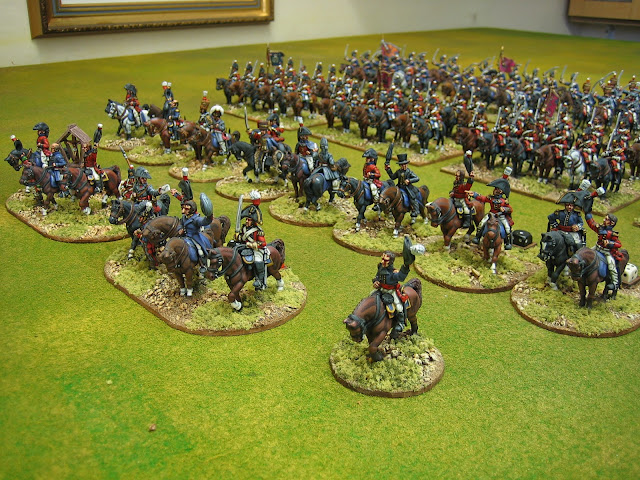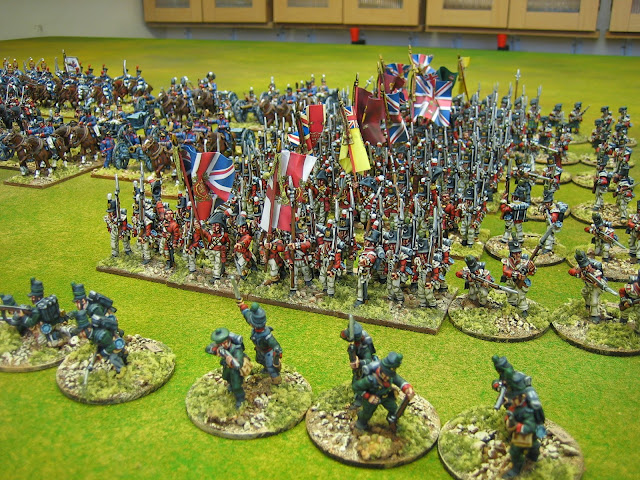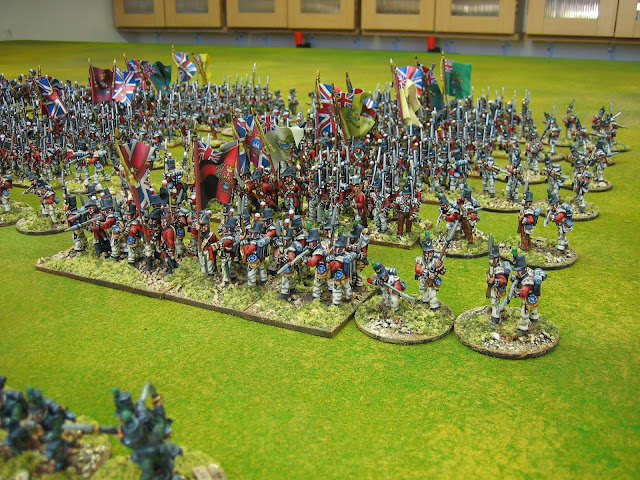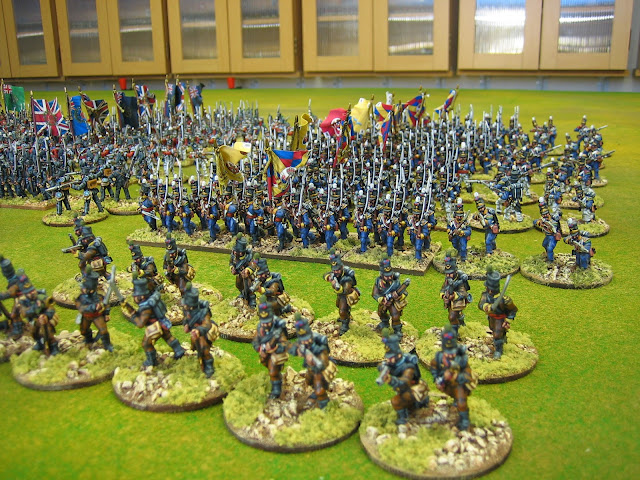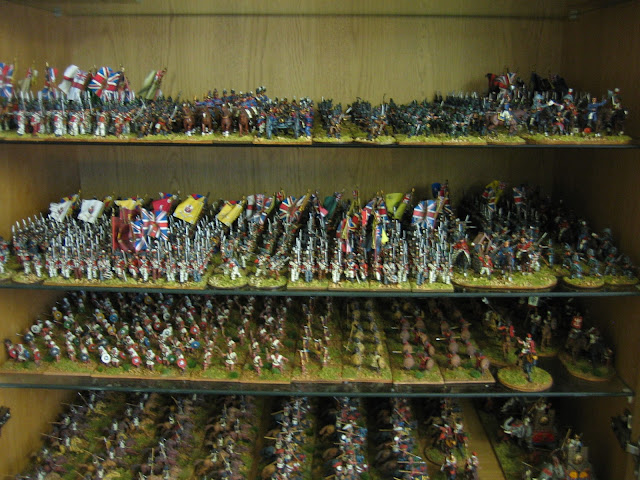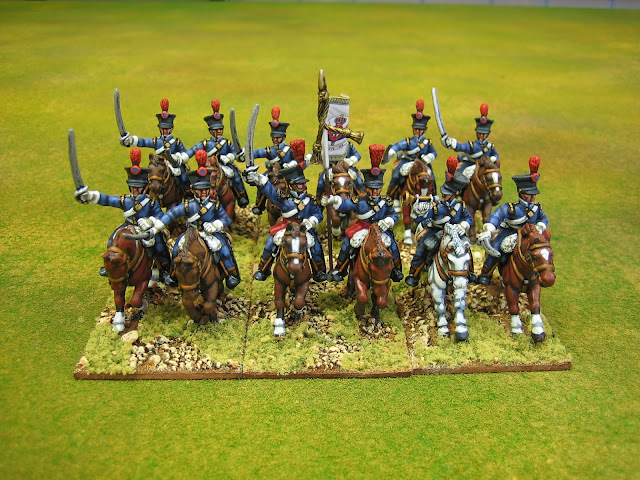As I mentioned in my previous post, since half way through this lot, painting has often seemed more like a chore than a pastime. However, there is always the feeling of satisfaction following the completion of an arduous task and that's pretty much how I feel now.
"Praise be.... There are no more Brits in the lead pile!"
Enough said.
This army comprises twenty eight units of 'formed infantry'; three skirmish units of Riflemen; eight units of cavalry; eight guns and crew, plus four limbers; twenty three extra skirmish stands; ten command stands.
All, except six KGL Light Infantry figures (Warlord) are FRONT RANK MINIATURES.
All were painted by myself using enamels.
Flags are a pretty even split between GMB Designs and Flags for the Lads. Both are excellent quality; GMB are printed on slightly thicker, shinier paper.
Bases are home cut 2mm MDF (square or officer stands), or War Bases (round for skirmishers). Basing is ink washed and dry brushed sand and grit finished off with foliage by Woodland Scenics (coarse turf: a burnt grass + yellow grass mix). Infantry / cavalry frontage is 45mm per stand.
The British infantry elements were the hardest to settle on because of the 'special troops' required for 1st, 7th and Light Divisions. Consequently, there are rather more special units, such as Highlanders, Guards and Brunswick Oels, than I would have chosen to do otherwise. Indeed, these three divisions grew the army well above the numbers I originally planned and in response the French army grew to match it - a definite case of mission creep.
At first glance the OOB seems incomplete. However, that is because I'm scaling my divisions (my basic command groups) at one unit to a thousand men and, more often than not, this means I need less units than were actually present in the divisions to make the divisions up. Furthermore, table space means collecting more would be practically pointless - I could never physically fit them on my table in any meaningful way.
A classic example of my incomplete OOB is having no 42nd (Black Watch) Highlanders for 1st Division. 1st division usually mustered about 7,500 men which works out at seven or eight units. Looking at the unit composition of 1st Division I decided it should comprise two Guard units, two Highland units (dropping one), one Highland Light unit, two KGL units (dropping two), and possibly one other British line unit (dropping one or two).
Gentlemen of the League (especially the former and serving officers of the Black Watch), please note that the renowned 42nd were dropped simply because I had flags for the Camerons and the Gordons and no flags for the 42nd - sorry, guys.
BTW, to the readers who kindly volunteered a donation of their spare flags to this project, thank you again.
The number of Portuguese Line units also seems a little low but, at one unit to one thousand men, there are enough Portuguese Line to furnish three Anglo-Portuguese divisions.
Outside of the afore mentioned divisions, the units I chose to paint had more to do with the flags I had than any specific OOB: They all fought in the Peninsular, and that's enough for me.
With the infantry figures I have, I can field five infantry divisions: 1st Division, Light Division and three other divisions, possibly including 7th Division (The Mongrels) all at the same time. Not bad, at all, and certainly enough for a big game.
A note on skirmishers: The number of skirmish figures attached to a unit does not represent proportionally accurate numbers. The number of stands (each two figures) equates to the unit's basic 'in game' skirmishing factor: A line unit has a skirmish factor of 2, so it gets two stands (four figures) even though this is proportionally too high for the number of figures in the unit; I could have halved the stands, or based less figures individually, but it didn't look as good. The British also have numerous independent skirmish stands that are used to bolster a division's overall skirmish factor - representing attached Rifle coys, Cacadores and such.
The composition of the cavalry (one unit equates to 500 troopers) is a total fudge because the variation in a cavalry division was quite extreme from one year to the next and I wasn't prepared to cater beyond eight units in this department. However, given that I only use a light or heavy cavalry type classification (with quality adjustments), and one unit can easily substitute for another within that confine, I decided to go for a 50 / 50 split. It remains to be seen if I'm right on this.
It all makes sense, kind of, to me at least, and here is my 'army'.
We start with command: Ten command stands plus an engineer.Two army commanders in Wellington and Beresford; plus an Officer of Engineers (an Officer of Engineers is often useful for scenarios).
Eight division / brigade / command group officer stands including two most definitely for the cavalry.
Before you all jump down my throat, I know Picton didn't wear the top hat and civilian coat in the Peninsular but, he wouldn't look like Jack Hawkins without it.
The Cavalry: Eight units, each 12 figures strong.- 1st and 3rd Dragoons; 1st and 2nd Dragoons KGL.
- 13th and 14th Light Dragoons.
- 10th Hussars
- 10th Portuguese cavalry
Should I have had one less heavy unit and one more light?
The Artillery: Eight guns and four limbers. Each gun has 4 crew figures.- Four guns (British Foot Artillery) plus two limbers.
- Two guns, (British Horse Artillery) plus one limber.
- Two guns, (Portuguese Artillery) plus one limber.
The Portuguese limber is not available from Front Rank as pictured here. It is a simple conversion - British crew with outer buttons removed, shoulder wings added, sword and sword belt added, and a Portuguese artillery crew head swap. More pics and info here.
The Infantry: Six units each of 24 figures plus 4 skirmishers: - 53rd Foot (Shropshire).
- 88th Foot (Connaught Rangers).
- 3rd Foot Guards (Scots Guards).
- 1st Battalion Coldstream Guards.
- 79th Foot (Cameron Highlanders).
- 92nd Foot (Gordon Highlanders).
The Guards, two units, are for 1st Division but could double as other units if the flag position is swapped around. The Union flag is not the King's colour in these units - it's the crimson one.
The Infantry: Six units, each 24 figures plus 4 skirmishers:- 50th Foot (West Kent).
- 27th Foot (The Inniskillings).
- 5th Foot (Northumberland).
- 9th Foot (East Norfolk).
- 11th Foot (Devonshire).
- 24th Foot (Warwickshire).
The Infantry: Five units, each 24 figures plus 4 skirmishers (Note: the Brunswick Oels have 6 skirmishers).- Brunswick Oels (7th Division).
- Chasseurs Britannique (7th Division, but can double as something else).
- 1st Battalion KGL
- 2nd Battalion KGL.
- 97th Foot (Queen's Germans, and with almost identical flags, can easily double as a third KGL unit).
The Infantry: Six Portuguese units, each 24 figures plus 4 skirmishers:- 8th; 9th; 12th; 13th; 16th; 21st.
Note the Cacadore skirmisher stands in the foreground. Cacadore units were invariably small, at around 400 actives, so they never quite hit the mark to be fielded as full units. I have chosen to make them additional division assets to be added to the divisional skirmish screens. They are painted as the 6th and the 8th Cacadores. The exception is in Light Division were I field one full unit to represent the multiple units therein (see below).
The Infantry: Four light infantry units each of 24 figures plus 8 skirmishers:- 52nd Foot (Oxfordshire) Light Infantry.
- 51st Foot (2nd West Riding) Light Infantry.
- 43rd Foot (Monmouthshire) Light Infantry.
- 71st Foot Highland Light Infantry.
52nd and 43rd are for the Light Division, 71st is for 1st Division and 51st is for 7th Division.
The Infantry: One unit of 24 figures plus 8 skirmishers; 3 units of 9 Riflemen (Skirmish order):- 3rd Cacadores
- 95th Rifles (skirmish units) x3
All four of these units are for the Light Division.
Finally, extra skirmishers for deployment to the divisional skirmish musters, each stand 2 figures (pictured above, out in front, on round bases):
- 6th Cacadores (5 stands).
- 8th Cacadores (5 stands).
- 95th Rifles (4 stands).
- 60th Rifles (3 stands).
- KGL Light Infantry (3 stands).
- Oels Jagers (3 stands).
Totals: Men 1040; Horses 145; Guns 8; Limbers 4; Ammunition carts 2.
So, am I short? Possibly. If I were to add, and I have no intention to do so, I'd add another unit of cavalry - either light dragoons or Portuguese - and a couple of units of Portuguese line infantry. But, and here's the rub, I don't want to paint any more of them. Nor do I have the storage capacity anyway - see below.
Now, there is one more part to this tale of woe: Don't let me get away without confessing a sin. It's a simple sin and, I think, one not often spoken of but shared by many: When conceiving and planning a collection I have more than history, or even a good game, in mind. In my view, there is no point collecting what you can't possibly store. Consequently, I do buy figures by the yard - there, I've said it.
The two pictures above shows just how much that this is the case: Crammed in they are, crammed into a strictly allotted space.
You will note two large spaces on the first French shelf above the cavalry (there's another completely full French shelf above that). I'm going to fill those spaces next, with two units of Legere, a unit of Chasseurs a Cheval and a second army command stand. That will completely finish the French.
Then I'll start the Spanish. It never ends....





























